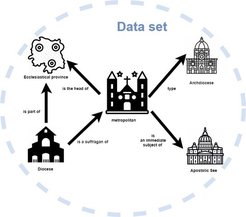Shaping the Concept of Ecclesiastical Global Governance: Ontological Modeling for the History of Ecclesiastical Administration
Completed Project

The development of information technologies has been subject to a series of transformations over the last year, moving from the documents web to the data web, and then to the linked (open) data (LD or LOD) web. In the field of knowledge engineering and representation, the Resource Description Framework (RDF) language is used, which enables making the stored data understandable, while ontologies as part of Linked Data are meta(data) schemas that formally describe concepts and their relations. This significant influence of ontology and semantic technology, on database design, promises advantages such as enhanced interoperability, knowledge sharing, and integration of data sources. Assuming, that the field of digital humanities is still maturing, I see the increasing need for support of the historical research domain that is based on heterogeneous data and divergent research questions. This makes it possible to record complex administrative relations, in time and space, at different geographical levels, and over time. After working for two years as a student assistant in charge of the Digital Humanities projects at the Max Planck Research Group Governance of the Universal Church after the Council of Trent, I decided to write my master thesis at the Johannes Gutenberg-University Mainz in collaboration with the research group.
The aim of this project is to develop a Web Ontology Language (OWL), an ontology-model for description of governance ecclesiastical entities of the Catholic Church and their changes overtime, adopting a Linked Data (LD) approach understandable by both humans and machines. This ontology is the necessary first step to the visualizations of governing, status and territorial changes over time and enables identifying the evolving of ecclesiastic geography in the Catholic world. The project is based on an initial data set elaborated by the research group, which contains the metadata of different phases in the historical stages of the governance ecclesiastical entities in the Catholic Church. In this frame, I will focus on the evolution of diocesan-like entities, which are of crucial importance in the databases the research group is elaborating. The dataset includes the variant names of dioceses (the standardized and alias names), the ecclesiastical administrative units as the categories of the ecclesiastical institutions, as well as their administrative affiliations in the context of canonical law in attachment to the temporal and spatial data in which they exist. A challenge will be to determine the change in the territorial partitions, which were defined, not by political borders, but ecclesiastical borders. This leads to the research questions: What is a suitable ontology approach to represent the administrative territories of the catholic dioceses? What are the benefits for the research project when applying this approach?
From the point of view of digital humanities, the project allows us to analyze an abstract and quantitative view of history of ecclesiastical administration and offers contribution as an interface to the scholarly community by defining the schematic structuring and its ontological representation for the legal archive materials in the Early Modern Age, particularly in the case of the positiones of Congregation of the Council. Finally, this may show new perspectives on how the judgments processes in the Roman Curia were managed, organized and carried out in the Early Modern Period, and plays a role in understanding the relations between ecclesiastical regions and the Apostolic See and between petitioners and legal professionals.
This project was completed with the presentation of the master thesis: “An ontology-based Approach for Modeling the Historical Development of the ecclesiastical administrative Units in the Catholic Church”, on 7 June 2022.
As a result of my master's thesis, an event-based ontology was conceived, which represents changes in the Catholic dioceses in a spatio-temporal sequence of historical events. The ontology model was defined as a domain extension of some CIDOC classes. Although CIDOC-CRM provides strong semantic expressiveness, this instrument was designed for modeling within the cultural heritage domain that set semantic limitations for modeling the structures of the administrative acts from a historical perspective. I also looked at other models for historical data based on the CIDOC model, but it was not suitable for grafting onto the data of the research group.
Therefore, to fill the methodological gap, I had to devise a suitable taxonomy for the initial dataset, which I used to apply additional subclasses and object properties to the model. The current version was developed using Protegé, an open-source ontology development tool comprising 77 classes and 124 object properties.
The task of developing an ontology is a crucial step from the data model for the data acquired by the research group towards an RDF export option. Moreover, it is a fundamental data model for the follow-up research project Orbis Dioecesium. Authority Data on Legal-historical Changes of Catholic Dioceses (OrDi).
